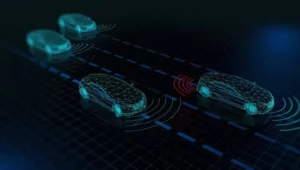The Law Commission of England and Wales and the Scottish Law Commission (the Law Commissions) has today (26 January 2022) published their joint report, making recommendations for the safe and responsible introduction of self-driving vehicles.
The report recommends introducing a new Automated Vehicles Act, to regulate vehicles that can drive themselves. It recommends drawing a clear distinction between features which just assist drivers, such as adaptive cruise control, and those that are self-driving.
Under the Law Commissions’ proposals, when a car is authorised by a regulatory agency as having “self-driving features” and those features are in-use, the person in the driving seat would no longer be responsible for how the car drives. Instead, the company or body that obtained the authorisation (an Authorised Self-Driving Entity) would face regulatory sanctions if anything goes wrong.
Nicholas Paines QC, Public Law Commissioner said: “We have an unprecedented opportunity to promote public acceptance of automated vehicles with our recommendations on safety assurance and clarify legal liability. We can also make sure accessibility, especially for older and disabled people, is prioritised from the outset.”
David Bartos, Scottish Law Commissioner said: “How should the law deal with self-driving technologies? Our joint report with the Law Commission sets out new laws for allowing automated vehicles on our roads, ensuring safety and accountability while encouraging innovation and development.”
Transport Minister Trudy Harrison said: “The development of self-driving vehicles in the UK has the potential to revolutionise travel, making every day journeys safer, easier and greener.
“This Government has been encouraging development and deployment of these technologies to understand their benefits. However, we must ensure we have the right regulations in place, based upon safety and accountability, in order to build public confidence. That’s why the Department funded this independent report and I look forward to fully considering the recommendations and responding in due course.”
Many driver assistance features are currently available to help a human driver. The report anticipates that, in future, these features will develop to a point where an automated vehicle will be able to drive itself for at least part of a journey, without a human paying attention to the road. For example, a car may be able to drive itself on a motorway, or a shuttle bus may be able to navigate a particular route.
A new system of legal accountability
Once a vehicle is authorised by a regulatory agency as having self-driving features, and a self-driving feature is engaged, the Law Commissions recommend a new system of legal accountability. Under it:
- The person in the driving seat would no longer be a driver but a “user-in-charge”. A user-in-charge cannot be prosecuted for offences which arise directly from the driving task. They would have immunity from a wide range of offences – from dangerous driving to exceeding the speed limit or running a red light. However, the user-in-charge would retain other driver duties, such as carrying insurance, checking loads or ensuring that children wear seat belts.
- The Authorised Self-Driving Entity (or ASDE) that had the vehicle authorised would have responsibility for it: if the vehicle drives in a way which would be criminal or unsafe if performed by a human driver, an in-use regulator would work with the ASDE to ensure that the matter does not recur. Regulatory sanctions would also be available to the regulator.
- Some vehicles may be authorised to drive themselves without anyone in the driver seat. Here any occupants of the vehicle would simply be passengers. Instead of having a user-in-charge, a licensed operator would be responsible for overseeing the journey. There would also be requirements for passenger services to be accessible, especially to older and disabled people
The Law Commissions’ recommendations build on the reforms introduced by the Automated and Electric Vehicles Act 2018. The 2018 Act ensured that victims who suffer injury or damage from a vehicle that was driving itself will not need to prove that anyone was at fault. Instead, the insurer will compensate the victim directly.
The Law Commissions recommend new safeguards to stop driver assistance features from being marketed as self-driving. This would help to minimise the risk of collisions caused by members of the public thinking that they do not need to pay attention to the road while a driver assistance feature is in operation.
The report has been laid before Parliament and the Scottish Parliament. It will be for the UK, Scottish and Welsh Governments to decide whether to accept the Commissions’ recommendations and introduce legislation to bring them into effect.
Matthew Avery, chief research strategy officer at Thatcham Research, an organisation which was part of the consultation for the Law Commissions’ report comments:
“The transition to safe introduction of automation with self-driving capabilities is fraught with risk as we enter the early stages of adoption. Today’s report is a significant step, as it provides important legal recommendations and clarity for the safe deployment of vehicles with self-driving features onto the UK’s roads.
“In the next 12 months, we’re likely to see the first iterations of self-driving features on cars on UK roads. It’s significant that the Law Commission report highlights driver’s legal obligations and they understand that their vehicle is not yet fully self-driving. It has self-driving features that, in the near future, will be limited to motorway use at low speeds.
“The driver will need to be available to take back control at any time, won’t be permitted to sleep or use their mobile phones, the vehicle won’t be able to change lanes and if the driver does not take back control, when requested, it will stop in lane on the motorway. It is critical that early adopters understand these limitations and their legal obligations.
He continues: “To ensure clarity around system capabilities and responsibilities there must be a clear separation between Assisted Driving, where the car supports the driver, and self-driving capability, where the car is responsible for the entire driving task. As such, we applaud the recommendations that compel carmakers to use appropriate terminology when marketing these systems, to prevent motorists from becoming convinced that their car is fully self-driving, when it is not.”
“Strong, independent safety assurance to build societal confidence, working in tandem with fast-moving and clear regulation is also essential to facilitating consumer understanding and adoption. It’s therefore reassuring to see that safety assurance, along with clarity around the driver’s responsibilities and liability should a collision occur, are key tenets of the Law Commissions’ report.
“The Law Commissions recommends that there must be access to data to understand fault and liability when a crash does occur. This will ensure rapid and efficient compensation, and the data will also allow car makers to identify where and how self-driving features can be improved to enhance future safety
“The insurance industry and the ABI have been working with the Law Commissions for several years, and we fully. We look forward to continuing to work with car makers and the UK Government to ensure the safe deployment of vehicles with self-driving capability.”
Thatcham Research and UK government organisation Zenzic are already working in partnership on a safety rating scheme for systems with self-driving capability. The intention is that this will become the benchmark for a global independent rating scheme for Automated Driving Systems, with a view to driving best practice and reassuring consumers that – when the technology is mature enough – it’s safe to hand over control.




















